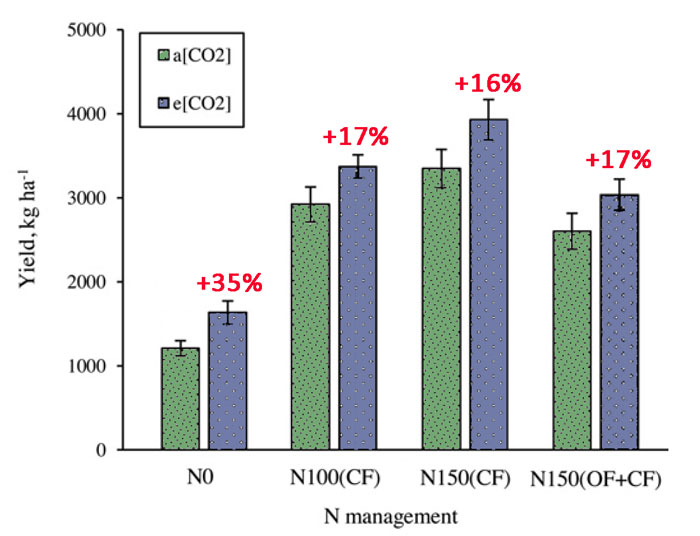| Tweet | Follow @co2science |
Paper Reviewed
Hazra, S., Swain, D.K. and Bhadoria, P.B.S. 2019. Wheat grown under elevated CO2 was more responsive to nitrogen fertilizer in Eastern India. European Journal of Agronomy 105: 1-12.
Wheat is the second most important food crop in India, which as a country produces around 11% of total wheat grain production. Such agricultural prominence led a trio of Indian researchers, Hazra et al. (2019), to investigate the effects of elevated CO2 and varying nutrient management strategies on the growth and yield of wheat (Triticum aestivum, cv. Sonalika).
The work was conducted in open top chambers at the experimental farm of the Agricultural and Food Engineering Department of the Indian Institute of Technology, Kharagpur, India over three growing seasons. Treatments included two CO2 concentrations (ambient at 394 ppm or elevated at 599 ppm) and four nitrogen (N) supply levels, including no N fertilizer addition (N0), normal N application via chemical fertilizer (N100(CF)), 50% higher dose via chemical fertilizer (N150(CF)) and a 50% higher dose via chemical and organic fertilizer (N150(OF+CF). CO2 enrichment was supplied between 8-10 hours during the day over the course of each growing season.
In discussing their findings, Hazra et al. report that various yield attributes (i.e., 1000-grain weight, average panicle length and weight, spikelets per panicle and filled grain percentage) all tended "to show positive response under CO2 enrichment in comparison to ambient CO2." With respect to grain yield, the most important agronomic parameter, Figure 1 illustrates that elevated CO2 increased it by 35% in the no N added treatment and by 16-17% under the three other nitrogen management regimes. Additionally, Figure 1 shows that grain yield was positively correlated with N application, where increases from 116-180% were observed (relative to the N0 treatment) at the normal and 50% above normal doses of N.
Consequently, in light of the above, Hazra et al. conclude that "wheat production under the elevated CO2 environment in Eastern India might be maintained or improved through the normal and increased dose of N fertilizer application." And that is really good news for a country whose population presently numbers 1.3 billion. Thanks to elevated CO2 and N management practices, wheat grain yields will increase in the future, helping to sustain one of the world's most populous countries.

Figure 1. Grain yield of wheat grown in open top chambers under ambient (a[CO2]) or elevated (e[CO2]) CO2 levels and under one of four nitrogen management treatments [N0, N100(CF), N150(CF), and N150(OF+CF)]. Percentages in red text indicate the yield response due to elevated CO2 for a given N management treatment. Source: Adapted from Hazra et al. (2019).




